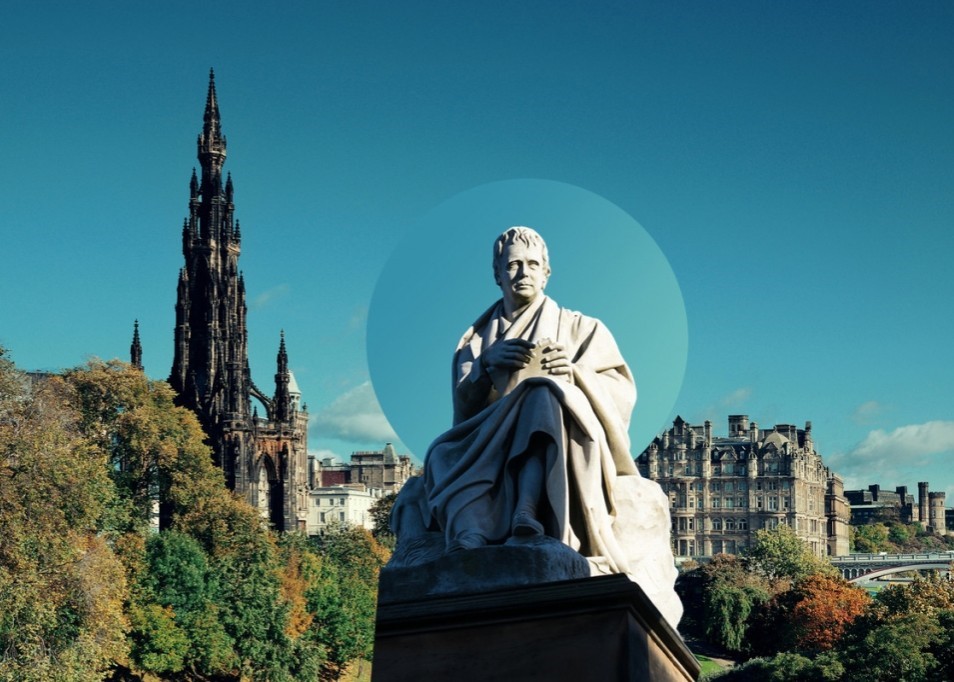
Living History
Sir Walter Scott believed that the material culture of the past could bring history to life. Ready access to things created, used and lost by the people of the past was essential to Scott’s inspiration and success as a writer of historical fiction. He was a passionate advocate of experiential learning: encouraging people to visit battlefields, landmarks and ruins; to explore the features of their landscapes, and to imagine their many histories playing out there in full cinematic colour. He was interested in hearing the lost voices and songs of the past, preserving languages and folk customs; in reimagining its buildings and in collecting and wearing historical clothing, arms and armour. All of this underlines his commitment to sensory engagement with the past, the most critical aspect of living history as we understand it today. Scott also had the foresight the appreciate that the present is merely history in the making, and he encouraged his friends to draw parallels between contemporary events and those in times past, using his home and collection as a springboard. Ultimately, through the costumed splendour of the Waverley Balls and King George IV’s visit to re-enactments of his novels on the stage, Scott gave birth to the version of living history we might recognise today.
Wellbeing
‘Wood, water and wilderness have an inexpressible charm for me.’ This is more than just the romantic sentiment of a poet: Scott knew that to live well, and to safeguard mental and physical wellbeing, a person should always be able to access and enjoy the natural world. The benefits of physical activity and open air, and the opportunities for conversation and creativity that such activities offered to those taking part, were all championed by Scott two hundred years before they found their way into the health and social policy so topical today. Scott lived his life with a visible disability, but he and his social circle placed the emphasis on what he could do rather than what he couldn’t, and it was never permitted to define him. His life at times was far from easy, and he weathered the stings of bereavement, financial hardship, depression and ill health with an indomitable spirit sustained by walking his woodlands and caring for his trees. Scott is one of very few nineteenth-century figures to talk candidly about their mental health issues and coping mechanisms.
Belonging
Scott was deeply receptive to the stories and experiences of other cultures and times, so much so that he collected artefacts and studied materials from across the world. He was able to appreciate the bigger picture of the human story in unique and refreshing ways. And yet, he would always consider himself a Scottish Borderer, wedded to the land that was part of his creed and home to his reiver ancestors. His baronial set celebrated his own roots and those of others descended from the people of the Borders, with Abbotsford as the metaphorical heart of the region. Throughout his writing career he endeavoured to show that a sense of place creates distinctive cultural identities, and that regional character and traditions can co-exist alongside one another to create a rich national tapestry.
Storytelling
Scott’s greatest gift was his talent for storytelling. He was able to animate the past by blending history and fiction together, knitting the real and the imaginary with such mastery that sometimes his inventions have become accepted as historical truth. In his private life and social engagements, he was recognised for the same craft, and it was the dramatic tone of his voice, the animation of his face and the sparkle in his eye that enraptured his audiences. To quote a contemporary, to hear Scott speak was like drinking champagne. His home is a three-dimensional example of his vast storytelling capabilities, where the antique, modern and imitation co-exist in unlikely harmony and decisions in design, decoration and craftsmanship are all intended to stimulate conversations, raise eyebrows and communicate messages on a number of levels.
Legacy
Sir Walter Scott is undoubtedly one of the most influential and relevant cultural figures of the last 200 years. His legacy still looms large in the spheres of architecture, international literature, tourism, lexicography, sustainability, biodiversity and landscape management. Right around the globe, there are places named after or connected with the man or his literary output. Scott’s impact in architecture and the decorative arts was the catalyst for Medieval Revivalism and the Arts and Crafts movement. His poems and novels put Scotland’s landscapes and her people on the map. But his legacy is far greater than the sum of its parts. For a voice from the past, Scott speaks to us intelligently about a whole host of contemporary issues, from national identity and internationalism to gender equality, industrialisation and revolution. Scott was a historical writer who looked toward the future with his eyes wide open, embracing progress whilst fiercely protective of the social values he felt were under threat. In an uncertain world, his perspective and insight has never had so much to offer us.
For more information on the 250th celebration for Sir Walter Scott see: www.WalterScott250.com


Walter Scott was born in North Britain but he died in Scotland. He was single-handedly responsible for the rehabilitation of Scotland through his writing.
He didn’t get monuments like that writing books; he got it for bringing Scotland back from the dead